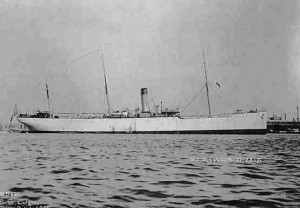- Author
- Smith, John, Cmdr, RAN (RTD)
- Subjects
- History - pre-Federation
- Tags
-
- RAN Ships
- None noted.
- Publication
- December 2010 edition of the Naval Historical Review (all rights reserved)
This article provides an interesting insight for all those who have suffered the travails of completing a midshipman’s journal.
In my time one of the many tasks inflicted on midshipmen was writing up a journal to be marked by the captain for inclusion in the midshipman’s final seamanship examination results. Instructions for compiling the journal included the following.
(a) The objects of keeping the journal are to train junior officers in:
– the power of observation
– the power of expression
– the habit of orderliness
(b) Junior officers are to record their observations about all matters of interest or importance in the work carried on, on their stations, in their fleet, or in their ships.
(c) They may insert descriptions of places visited and of the people with whom they come in contact, and of harbours, anchorages and defences.
The keeping of journals was not confined to the Royal Navy and the Royal Australian Navy but was common practice in foreign navies including the United States Navy. This article relates specifically to the journal of USN Cadet Joseph K. Taussig and in particular to his observation on ‘Australian Defences’ in 1901.
To understand the relevance of the date, reference is made to two articles by Bob Nicholls in the Naval Historical Review Vol. 23 No 4 and Vol. 24 No 1, which summarises United States and British Empire relations at the beginning of the 20th century. As remote as it may seem today, at that time to some in America the British Empire was regarded as potentially hostile and there was a ‘Plan Scarlet’ covering possible aggression with Australia. The Great White Fleet of 1908 included an intelligence team tasked with producing plans for attacking Auckland, Sydney, Melbourne, Albany, Fremantle and Perth. It is not therefore surprising that a USN cadet’s journal of this period should contain comments on the defence of Australian ports.
Here we come across Cadet Joseph Knefler Taussig, USN who was accepted into the US Naval Academy at Annapolis in 1895. Joseph was the son of Rear Admiral Edward D. Taussig. At this stage training in the US Naval Academy, which was not using the title midshipman, involved four years of academic training at Annapolis in Maryland, followed by another two years at sea, and after final examinations there was usually a wait for a vacancy for promotion to ensign.

During summer vacations at Annapolis cadets also served for short postings to fleet units. During his final year at the Academy Cadet Taussig was posted to the battleship USS New York and saw action in the Spanish-American War in the Battle of Santiago in July 1898. After graduation he was posted to USS Culgoa – she retained her original Australian name throughout her lengthy service in the USN.
USS Culgoa,
Sydney NSW,
May 1, 1901
INTELLIGENCE REPORT ON FORTIFICATIONS OF SYDNEY HARBOUR AND THE MILITARY ORGANISATION OF NEW SOUTH WALES
Sir:
1. In obedience to your order of April 1, 1901, I have the honour to submit the following report.
2. Batteries, gun-pits, etc. are distributed along bluffs at the entrance to the harbour, and immediately inside the heads, forming a double line of defense, which may undoubtedly be very effective on account of the natural advantages afforded.
Many of these batteries are concealed by trees and brush so that they cannot be seen by vessels entering the harbour. The exact types and calibres of the guns installed could not be ascertained, but many of the guns are old muzzle loading smooth bores and rifles of large calibre. There are a number of 5″ breech loading rifles also.
3. The most important batteries are distributed as follows: On the Inner South Head a battery facing seaward, and one near Camp Cove facing the harbour: On Middle Head two batteries facing the harbour entrance: On Georges Head a battery facing the harbour entrance: A large battery on Shark Point: Extensive batteries and gun-pits on Bradley Head. The batteries are manned by the permanent artillery forces, and regular target practice is carried out annually.
4. At Chowder Bay the submarine mine station is located. This is fitted out with extensive mines of modern types, together with necessary appurtenances. The mines are in charge of a permanent force known as the Submarine Miners. A practical course in laying mines is carried out during two weeks of April each year. A vessel to be used solely for laying and taking mines is under construction.




